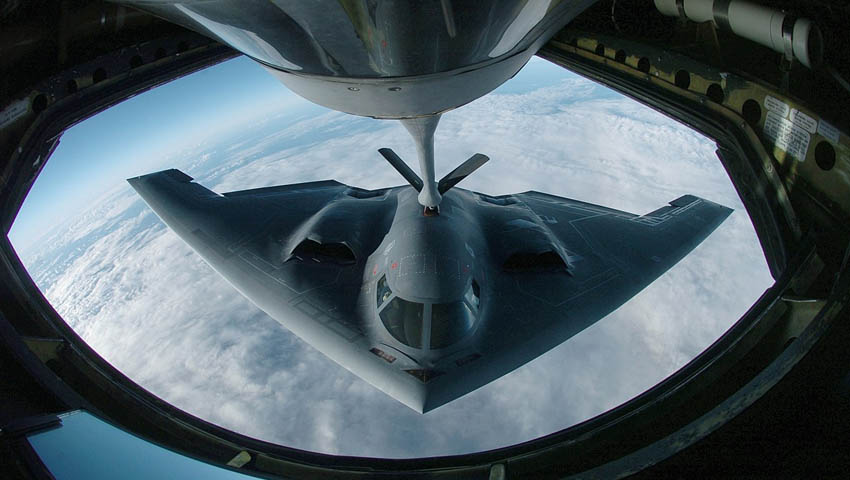The retirement of Australia’s fleet of F-111 tactical bombers in 2010 left Australia with a severely reduced aerial strike capability – the advent of increasingly reliable and complex unmanned aerial and autonomous systems is presenting Australia with a number of options to fill the nation’s long-range strike gap.
To continue reading the rest of this article, please log in.
Create free account to get unlimited news articles and more!
Long-range strike, typically conducted by strategic bombers and tactical strike bombers or smaller fighters supported by air-to-air refuelling and airborne early warning and command aircraft, serves as a complementary doctrine to air dominance, with each serving a unique yet symbiotic role in the survivability and effectiveness of tactical units and the broader strategic deterrence.
For Australia, the retirement of the F-111 platform, combined with the the limited availability of the Navy's Collins Class submarines, left the nation at a strategic and tactical disadvantage, limiting the nation's ability to successfully intercept and prosecute major strategic strikes against air, land and sea targets that threatened the nation or its interests in the 'sea/air gap', as defined in the 1986 Dibb review.
While the acquisition of the Super Hornets in the mid-to-late 2000s and the acquisition of the fifth-generation F-35 Joint Strike Fighter to fulfil a niche, low-observable limited strike role have both served as a partial stop-gap for that lost capability, the nation has not successfully replaced the capability gap left by the F-111.
Additionally, the recent announcements about Australia's pursuit of an advanced remotely piloted aircraft system (RPAS) as part of the AIR 7003 program and the advent of the Boeing Airpower Teaming System – designed by Boeing in collaboration with Defence Science and Technology (DST) to enhance the air combat and strike capabilities of the Royal Australian Air Force.
The acquisition of the Reaper-based RPAS, MQ-4C Triton and development of the fighter-like Boeing Airpower Teaming System all serve niche roles as part of a broader and increasingly complex air dominance, intelligence, surveillance and reconnaissance and close-air support strike mix – neglecting the critical long-range strike capabilities once filled by the F-111.
Australia is not alone in its pursuit of these increasingly capable and reliable unmanned/autonomous systems, the US, the UK, France, Germany, Russia and China are all at various stages of development or operating such systems. This seemingly global race, particularly the pursuit of 'optionally-manned' long-range strike systems, like the B-21 Raider, and Australia's long-range aerial strike gap presents unique opportunities for Australia.
Avenues for international collaboration
The precedent already established by the collaboration between Defence Science and Technology and Boeing on the development of the 'loyal wingman' concept provides avenues for Australia to partner with defence industry primes and global allies to develop a long-range, unmanned, low observable strike platform with a payload capacity similar to, or indeed greater than, the approximately 15-tonne payload of the retired F-111.
The US has developed increasingly capable long-range, low observable unmanned platforms including the Lockheed Martin RQ-170 Sentinel; the highly-secretive Northrop Grumman RQ-180 high-altitude, long endurance, low observable intelligence, surveillance and reconnaissance aircraft; and Northrop Grumman's X-47 series of carrier-based, low observable strike platform.
Meanwhile, BAE Systems has successfully developed and tested the Taranis unmanned platform at the Woomera Test Range as a proof of concept for future collaboration and development – each of these individual platforms provide a unique opportunity for Australia to collaborate with a global industry prime and a global ally to fill a critical capability gap for each of the respective forces.
Such a capability would also enjoy extensive export opportunities with key allies like the US and UK, who could operate the platform as a cost-effective replacement for larger bombers like the ageing B-52H Stratofortress, B-1 Lancer and B-2 Spirit, and complement the in-development B-21 Raider long-range strategic bomber.
For the UK, the co-development and participation in such a system will fulfill a unique role – complementing the air-to-air and air-to-ground strike capabilities of the Eurofighter Typhoon and F-35 Joint Strike Fighter as a low observable, long-range, heavy strike aircraft to counter the rapidly modernising bomber fleet of an increasingly resurgent and assertive Russia.
Similarly, Australia needs a credible, long-range strike option capable of replacing the lost capability of the F-111 to penetrate increasingly advanced and complex integrated air defence networks and anti-access/area denial (A2AD) systems rapidly developing in the Indo-Pacific region.
The introduction of such a system could also support the development and eventual modernisation of the US B-21, which is being developed in response to the increasing air defence capabilities of both Russia and China, particularly the widespread introduction of the S-300 and S-400 integrated air and missile defence systems.
In the years following the end of the Second World War, long-range air power in the form of the Canberra and later the F-111 bombers served as critical components in the nation's air power arsenal. The long-range tactical and strategic deterrence capabilities of such platforms, combined with the qualitative edge of Australian personnel and technological advantages of these platforms, ensured Australia unrestricted air dominance against all but the largest peer competitors.
The rapidly evolving regional environment requires a renewed focus on developing a credible, future-proofed long-range strike capability for the Royal Australian Air Force to serve as a critical component in the development of a truly 'joint force' Australian Defence Force capable of supporting and enhancing the nation's strategic engagement and relationships in the region.
Let us know your thoughts in the comments section below, or get in touch with

 Login
Login







